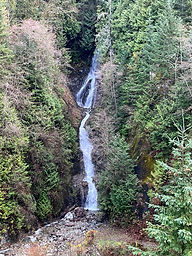Whyte Lake Fire Responder Shares An Insider's View

This week's wildfire near Whyte Lake in Cypress Falls Park was successfully extinguished through the combined efforts of firefighters on the ground and in the air.
The Watershed spoke with Air Attack Officer Greg Adams about the effort required to smother this particular fire.
When the call came in Monday around noon to the air tanker base in Campbell River, Adams says he and his team were ready.
BC Wildfire Service divides the province up into regions, and the Coastal region– which is Adams' jurisdiction– includes all of Vancouver Island inland to east of Hope, and extends up through Haida Gwaii. However, although the fire was near Horseshoe Bay, he and his team weren't the first on the scene, as they had to fly across from Campbell River.
"When West Van Fire Rescue requested air support from BC Wildfire Service, the call was routed through to Kamloops," Adams explained in an interview this week. "First air support on the scene were two tankers and a birddog, who flew in from the Interior, already loaded with fire retardant."
A birddog, Adams explains, is a small fixed-wing aircraft that accompanies every aerial firefighting effort. The plane carries only a pilot and an Air Attack officer, who gives tactical direction to the airtankers and waterbombers, and facilitates communication with the firefighting teams on the ground.
The two air tankers routed from Kamloops are RJ85s, former commercial jet aircraft that have been retrofitted with exterior tanks to hold more than 11,000 litres of fire retardant each.
"In the birddog, we do a test run along the flight path prior to the arrival of the other aircraft," Adams said. "We check out any terrain hazards like radio towers or power lines, and make note of issues with gusting winds or other factors that could complicate the drops."
On Monday, the air tankers and their birddog arrived from Kamloops already loaded. After releasing the retardant, they flew to the air tanker base in Abbottsford to reload, a process that takes only eight or nine minutes once the aircraft is on the ground, according to Adams. A total of five loads of retardant were released before the water bombers arrived. Pilots are careful not to drop the retardant into water if they can help it, as the anti-corrosive material can be toxic and contaminate bodies of water.
As the second birddog on the scene, Adams and his pilot were ready to relieve the first crew when they ran low on fuel. "I'm not a pilot," said Adams. "As Air Attack Officer, it's my job to maintain a communications link between the folks on the ground, the team at the fire centre and the pilots. We trace the flight path first, and then move out of the way and tell them where to drop, giving a 3-2-1 countdown if needed to ensure the water goes down onto the best spot."
Clear communication is essential to ensure that the material being dropped, whether it be retardant or water, lands on the fire but away from firefighters battling on the ground.
The water bombers are also known as 'skimmers', and are purpose-built for firefighting efforts. The planes are Air Tractor 802 Firebosses, and are very similar to crop-spraying craft, albeit bigger. "The floats make them good for fires," explained Adams, "so they can get down to the water and reload quickly before returning to the air."
There were six skimmers working on the Whyte Lake fire, circling and scooping water from Howe Sound before deploying it onto the flames. Adams said that there is no real difference to fighting fires using salt or fresh water, and accessibility is the key. He added that Whyte Lake is too small to facilitate easy water removal from anything but a helicopter.
Adams noted that there were also two helicopters on the scene; one that brought a crew in from Squamish, and one briefly dumping bucket-loads of water onto the fire.
"The fact the fire was near Horseshoe Bay made things more complicated," Adams said. "The airspace is controlled, so in addition to talking to the Incident Commander on the ground and directing the skimmer pilots, we also needed to coordinate with the Harbour Tower to keep the airspace clear."
Adams is in his tenth season as an Air Attack Officer in BC, after having worked for 18 years as a firefighter in Alberta. Aspiring Air Attack Officers require a broad level of experience fighting a wide range of ground fires before beginning the certification process. It takes at least two years of experience, with classroom-based training combined with flight simulators and in-plane training before Air Attack Officers can be certified by BC Wildfire service.
Adams points out that one of the big concerns faced by airborne firefighters these days is the presence of drones in the area of a fire. "If any of our pilots spots a drone nearby, all operations have to stop, as they represent a catastrophic risk," he said.
The other problem is climate change. While Adams notes that each fire season is unique, he says that "this year we've had an abnormally active start." He adds that in the last ten years, there have been more bad seasons than there were in the prior decade.
Not reassuring news, particularly for a village like Lions Bay that perches on the forested side of a mountain. When asked what residents can do to help, Adams offers practical advice. "Be careful with any of your outdoor activities, be mindful of the regulations that are in place, and if you see smoke, report it."
Share your thoughts on the this summer's early jump into the fire season by leaving a comment below, or emailing editor@lionsbaywatershed.ca


Comments